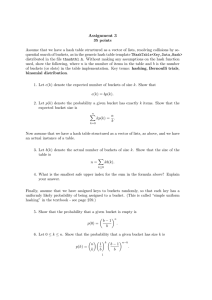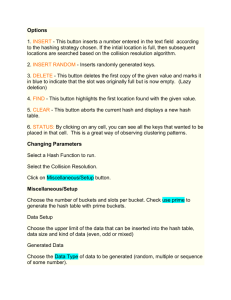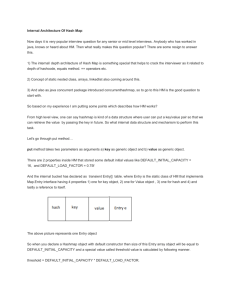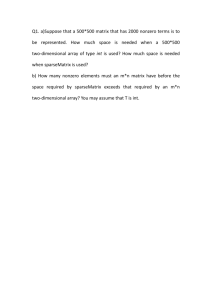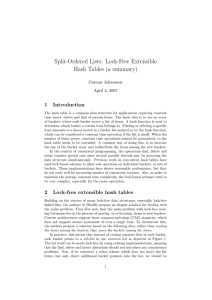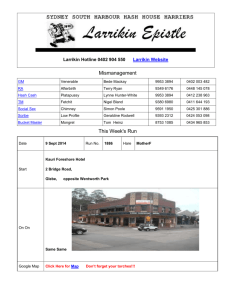CSE 444 Homework 3
advertisement
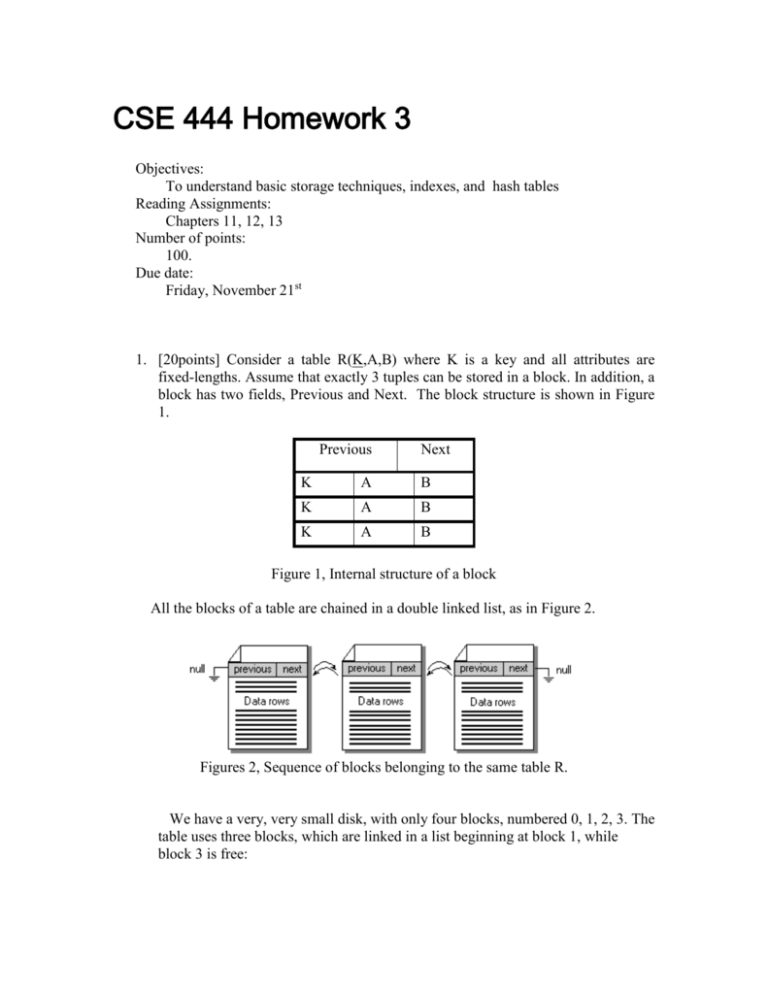
CSE 444 Homework 3 Objectives: To understand basic storage techniques, indexes, and hash tables Reading Assignments: Chapters 11, 12, 13 Number of points: 100. Due date: Friday, November 21st 1. [20points] Consider a table R(K,A,B) where K is a key and all attributes are fixed-lengths. Assume that exactly 3 tuples can be stored in a block. In addition, a block has two fields, Previous and Next. The block structure is shown in Figure 1. Previous Next K A B K A B K A B Figure 1, Internal structure of a block All the blocks of a table are chained in a double linked list, as in Figure 2. Figures 2, Sequence of blocks belonging to the same table R. We have a very, very small disk, with only four blocks, numbered 0, 1, 2, 3. The table uses three blocks, which are linked in a list beginning at block 1, while block 3 is free: Block 0 Block 1 2 NULL NULL 2 40 Free Free 10 20 Block 2 1 0 Block 3 NULL NULL 30 Free Free Free Figure 3, Sequence of blocks filled out with data Tables with no clustered index are called heaps and one of the available insertion policies in SQL Server is to insert a new row into the least populated block. Call this the best-fit policy. That is, the physical storage engine gives preference to the blocks that have more free space when it makes a decision which block will contain a newly inserted row. In the case of a tie, the block with the lowest number is chosen. However, that policy could not be used when dealing with clustered tables, which have a clustered index defined. In this case we will assume that existing records cannot be moved between blocks, and that the smallest key in each block cannot change after an insertion. Show the result of inserting records with the following keys: 35, 39, 25, and 28. Your answer should consists of 2 figures like Figure 3, one for each of the following cases: a. The table is a heap. Use the best-fit policy. b. The table is a clustered table. 2. [15 points] Consider the following two insertion policies for a heap. The best-fit policy mentioned above inserts a new record into the block with most free space. The first-fit policy inserts a new record into the first block in the list that has enough space to hold it. Why is the best-fit policy better than the first fit policy ? Choose one of the following: a. It saves disk space. b. Deletions are more efficient. c. Updates of variable length fields are more efficient. d. Insertions of new records are more efficient. 3. [20 points] This is adapted from exercise 12.3.7 in the book. Suppose that blocks have 4096 bytes, and each record has 100 bytes. Suppose that the block header contains 2-byte pointers to each record within the block. We start with an empty block, and each day insert two new records and delete one record. The insertions take place before the deletion. a. Assume records can be deleted without placing a tombstone. After how many days will we run out of space in the block ? b. Assume we have to leave a tombstone in the form of a null pointer in the block’s header, whenever we delete a record. After how many days will we run out of space in the block ? 4. [15 points] Suppose keys in an extensible hash table are hashed to four-bit sequences, and that blocks can hold four records. The hash table indexes the most significant bits first. We start with a hash table with two empty blocks (corresponding to 0 and 1). Show the organization after we insert records with keys: a. 0000, 0001, 0010, 0011, …, 1111 b. 0000, 1000, 0100, 1100, …, 1111 (i.e. same as above, but with bits in reverse) 5. [25 points] Hash functions Mr. Frumble decided to implement his favorite hash function as follows: hash(s1s2...sk, n) = (i=1,n si ) mod n An implementation in Visual C++ is given here: hw3-hash.cpp Most major database systems use this hash function, so Mr. Frumble thought he won't be fired for implementing it this way.. In this application he has to match a large number of financial transactions with a set of 10000 bank accounts, and wants to use the hash function to partition the accounts into 100 buckets. "That should give me about 100 accounts in each bucket, give or take a few", thinks Mr. Fumble, "and for each new transaction I need to search the matching bank account only in one bucket, so I should be able to find the account after only 100 comparisons, on average". Mr. Frumble has a point, since the accounts are really very uniformly distributed: namely, they are the following strings:: A0000 A0001 A0002 .... A9998 A9999 That is, each account starts with the letter 'A', followed by four digits. Each of the ten thousand possible combinations of digits occurs exactly once. But, to Mr. Frumble's surprise, the application runs much slower than he expects. Each new transaction seems to require significantly more than 100 comparisons. a. [10 points] Help Mr. Frumble understand what is going on, by drawing the histogram of the bucket sizes. This is a graph whose Ox axis has values 0, 1, 2, ..., 99 corresponding to the buckets, and the Oy axis has values between 0 and 10000, showing the number of accounts in that bucket. You have a turn in a graph generated by any tool (say Excel, or gnuplot, or mathlab, etc). To generate the data for this graph you may either write a C++ program (you may use the hash function hw3-hash.cpp) or you may derive a mathematical formula that computes the size of each bucket, then run it on Excel or on any other tool. Please turn in any auxiliary material that you used to generate the graph. b. [5 points] Using the data you collected at point (a), compute how much slower Mr. Frumble's application runs compared to what he expected. The running time for the application is quadratic in the number of items in a bucket: that is, if the buckets have 4, 52, 9, 125, 58, ... items each, then the running time is 42+522+92+1252+582+... Mr. Frumble expects a running time of 1002+1002+…+1002 since he expected all buckets to have the same size. Compute how much larger the real running time is compared to what Mr. Frumble expects. c. [10 points] Design a better hash function that would partition Mr. Frumble's accounts more uniformly, and show the new histogram. Compute the running time at point (b) for your new hash function. Notice that there is no best solution here, feel free to use your creativity. You have to turn in both a program implementing the new hash function, a histogram, and a number indicating the running time. 6. [5 points] Please answer (online) the following questions 1. 2. 3. 4. 5. How long did it take you to complete this assignment? What did you like the best about this assignment? What did you like the least about this assignment? What helped you learn the best in this assignment? What distracted from your learning in this assignment?
